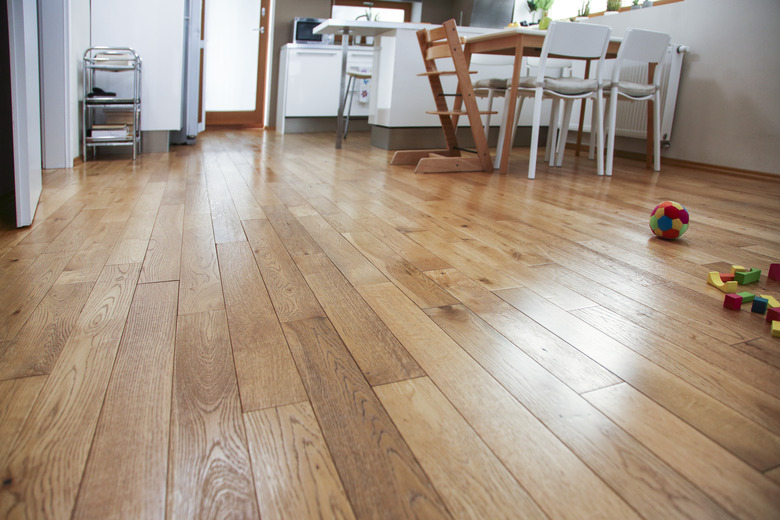How To Get The Grey Out Of Hardwood Floors
Hardwood floors turn gray after their protective polyurethane coating wears off and they're exposed to moisture. To get the gray out of hardwood floors, you'll need to sand and reseal them. If you want to completely change the color of your hardwood floor, this is a great time to do so. If not, sanding will remove the gray areas (as long as the damage isn't too deep) and a fresh coat of polyurethane will go on clear to preserve the original color of your hardwood floor.
Be sure that your floor is composed of true hardwood or a thick hardwood veneer before you begin. Many engineered wood floors cannot withstand sanding and resealing due to its incredibly thin "wear layer." The pressed wood underneath this wear layer isn't very attractive. Consider replacing this type of floor when its wear layer is gone or consult a professional about other options.
Prepping the Room for Resealing
The first thing you need to do to get the gray out of hardwood floors is to sand away the remaining layer of polyurethane and any of the superficial gray areas. This means everything in the room will get very dusty. To cut down on your cleanup and to save your HVAC and electrical systems from a dust invasion, cover vents and wall outlets with plastic and securely tape the edges. Consider taping windows and doorways as well.
You'll also need to clear the room of all furniture and wall hangings. Use a flat pry bar to carefully remove the quarter rounds around the perimeter of the room to help you sand and seal the floor's edges as well.
Don't forget to prepare for your personal protection. Wear a dust mask and protective eye gear before turning on a sander. Use hearing protection to block out the sound of the sander and wear knee pads when you need to do detail sanding.
Sanding the Gray Out
Renting a flooring orbital sander is a good choice for beginners because it will not leave awkward scratch patterns regardless of whether you work with or against the grain. However, this sander only works on flat floors. The sanders powerful enough for flattening an uneven wood floor (drum and rotary sanders) are actually so aggressive that, according to Build Direct, they can quickly cause damage in the hands of a novice. If you think your floor is in bad enough shape to require this extra power, call a pro.
You can reach the last few inches around the perimeter that the larger floor sanders cannot access with a handheld power sander. They tend to be small, so it may take a while to do all the edges, but they are effective.
You'll do several rounds of sanding with different grits and will need to purchase sand paper that fits all of your machines. American Sanders recommends starting the first pass with 36- or 40-grit sandpaper. Then move up to a 50- or 60-grit sandpaper and finally finish up with an 80- or 100-grit sandpaper. Use a shop vac with a brush attachment to clean up dust between each round.
Resealing a Hardwood Floor
Vacuum dust off the walls and remove the protective plastic coverings. Run a damp mop over the floor to catch any remaining dust so that the polyurethane coat goes on completely smooth. If you're using an oil-based product, make sure the room is well-ventilated before beginning due to its strong smell.
Paint a smooth coat of polyurethane along the edge of the floor to ensure complete coverage. Then use a special finish applicator to efficiently cover the rest of the floor. The main goal is to avoid bubbles and debris, so work slowly and smoothly. Follow the instructions on your particular brand of polyurethane sealant for drying times and repeat application recommendations.
